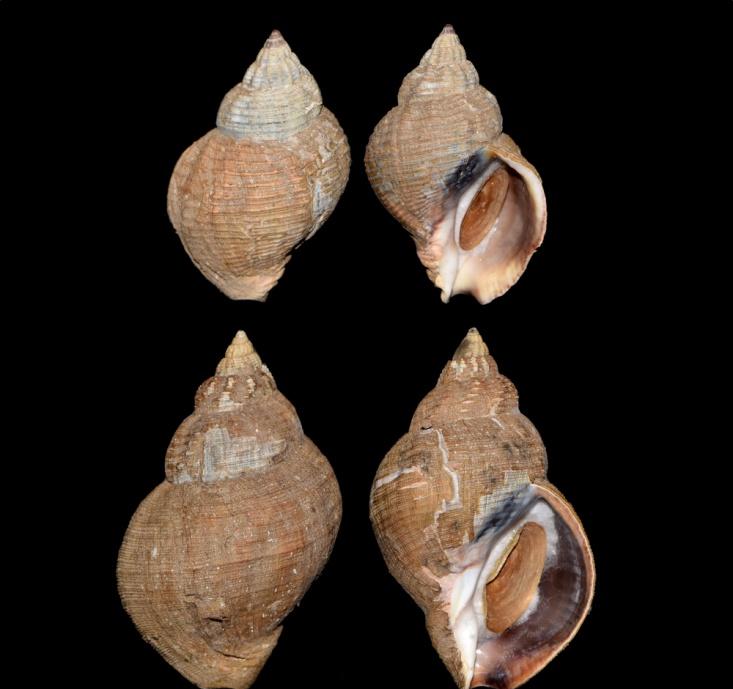E-snail is a neogasste, E-snail family, the family of large population, distributed all over the world, this shellfish color is flat, but the snail shape is more varied, different areas of species differences. Today, Xiaobian takes you to know a kind of snail that is particularly loved by the people in the English Channel and the North Atlantic Coast - the European snail.
European Ebony
Latin scientific name: Buccinum undatum (Linnaeus, 1758)
English name: Common Northern Whelk

Collect the Eluo specimen shell remember to keep the mouth cover
The shell is ovate or ovoid-conical, i.e. elongated cone-shaped. The screw top is medium strength and sharp. The screw shaft is smooth and straight, but not flat, with an inflated base and is usually covered by a wide, flattened, translucent calcareous callos callum. Sometimes folds are visible at the bottom of the screw shaft. The shell mouth is large aperture oval or rectangular, with a deep cut in the front and no siphon. The outer lip is flat, sometimes curved, and forms an edged exterior. lid, light, ovate and with concentric stripes. The shell surface is creamy yellow or pale grey, sometimes with brown spiral bands at the sutures and in the middle of the body layer; fresh shell surfaces are slightly greenish.
The European snail is compact and is one of the favorite foods of cod, and many snails are found in the stomach of the fish! The Nordic countries and several traditional seafood consumers along the Mediterranean coast also love to eat snails.
Why is Eluo so popular?
Mainly because it tastes good because it is eaten well!
Snails are carnivores and feed mostly on polychaete worms and other mollusks.
Feeding on bivalves. It uses the edges of the shell to lure open double shells. After the prey approaches, it drills holes in the shell of the prey through the friction of the teeth and tongues, while using the corrosive effect of the secretion to accelerate the drilling to feed on the soft tissues inside it.
The drawing shows a conch devouring a shell. The conch had climbed to the back of the cockle, its feet firmly attached to the shell of the clam. Then, after finding the opening with the tip of the tentacle, it forces its front lip into the clam, enough to insert its beak and start eating.
The European snail can insert its beak into a cockle with an opening as small as 1.3 mm and swallow it. Nelson further reported that the 2-inch-long conch had completely emptied the clam, which was about 1 inch long, in 10-20 minutes.
Usually in such a "life and death contest" situation, a large wedge-shaped force will be generated, sometimes even enough to break the "crushed bones", either a conch or its prey.
Snails also sometimes feed on dead or damaged marine animals.
It can sniff food from a great distance. In search of food, it stretches out a tube called a "siphon" (an organ that most shellfish rely on to feed and breathe) that carries water to the gills while also having a sense of smell.
Eosophroditic is an ectroditic and reproduces sexually.
The breeding period is between October and May of the following year, and the resulting eggs attach to solids such as rocks and shells, forming protective capsules on the eggs, each containing up to 1000 eggs, and sometimes several capsules are grouped together to form more than 2000 large clumps.
Only a few of these eggs develop; most are used as a source of nutrition. There is no floating period, and after a few months, the cub crawls out of the capsule.
The empty egg balls exposed to the beach are often mistaken for sponges, also known as "washed balls"...
Distribution range:
It is common off all coasts of the UNITED Kingdom and is widely distributed from Iceland and Norway to the Gulf of Biscay and throughout the North Atlantic.
European snails generally live for 10 years. It is commercially fished; most conchs are exported to the Far East.
The graphic data in this article comes from Wikipedia, Marin Marine Biological Information Network, Fisherman Collection Network, etc.
For more information, you can search for the "Shell Red" public account on WeChat or log on to the official website of Shell Red http://www.beike.red/ learn more wonderful content.